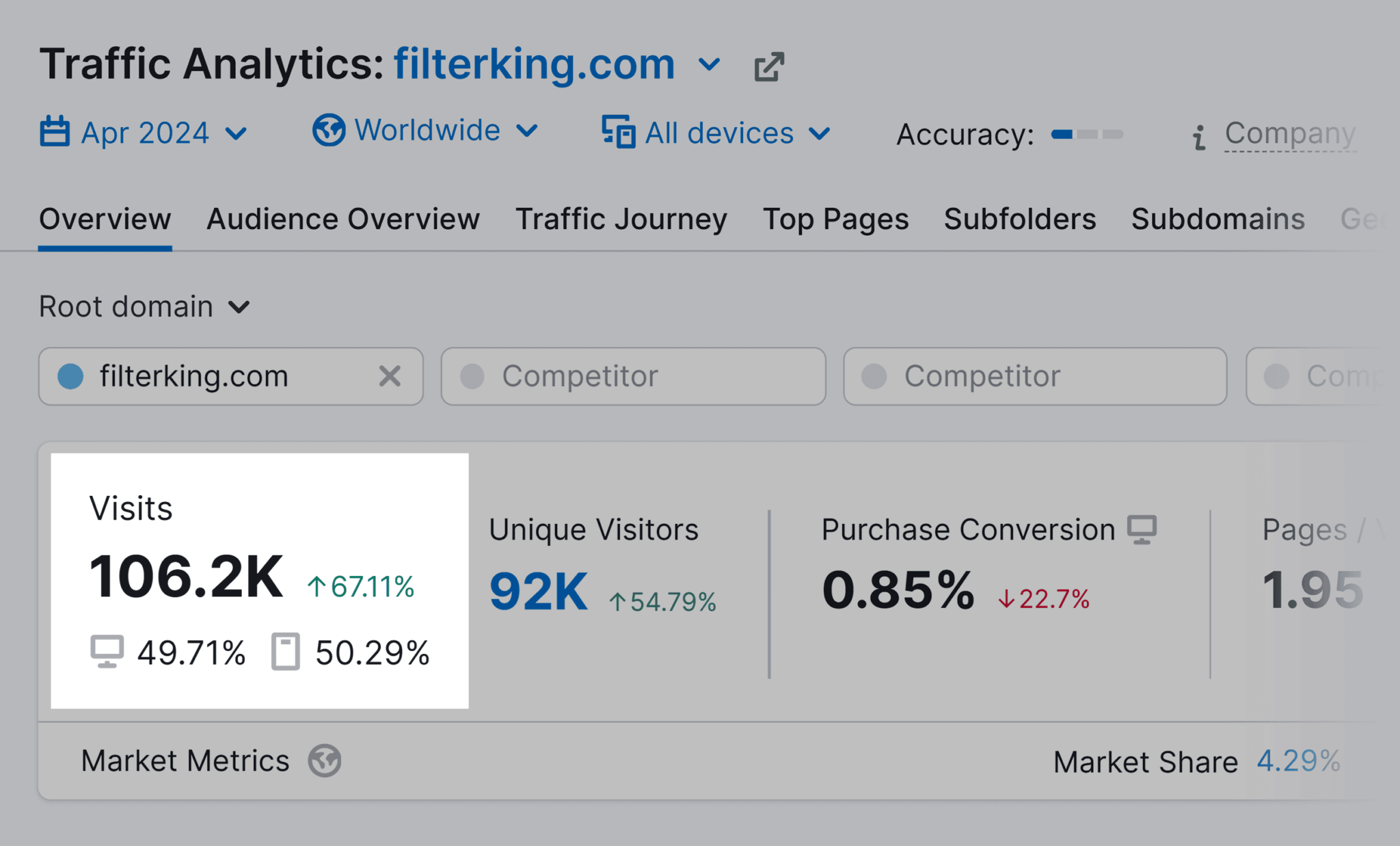Ecommerce Marketing: 11 Strategies to Drive Traffic and Sales

Ecommerce marketing is the process of making potential customers aware of your online store and generating sales. Using channels like search engines, social media, blog content, and email.
When you implement the right ecommerce marketing strategy, you can make a big impact on your business’s performance.
For example, FilterKing.com skyrocketed from 0 to $460K in revenue with a solid ecommerce SEO strategy and Paid Ads, now attracting 100K monthly visitors.
In this post, we’ll give you 11 ecommerce marketing strategies to help grow your own traffic, brand awareness, and sales.
1. Add User-Generated Videos to Your Product Pages
Use video content to show off your products and educate customers. It can help you connect with customers while promoting your products. Potentially leading to boosted sales.
Take goPure, for example. The beauty brand added shoppable content carousels to its landing and product pages.

These let viewers shop products directly through links within the video.

The goal was to help visitors make informed buying decisions based on real-life experiences shared by other customers.
These videos led to 1,705 orders for goPure within 60 days. They also helped generate $200K in revenue with a 13% average conversion rate from video-engaged visitors on the site.
There are lots of other video marketing formats you can use to engage your audience. And the videos don’t even need to be on your website.
For example, you could:
- Work with influencers (more on them later) to create unboxing videos on platforms like TikTok or YouTube
- Create explainer videos showing customers how to use your products
- Put together behind-the-scenes videos of the manufacturing process
2. Optimize Your Webpages with SEO
Search engine optimization (SEO) can help your product pages rank higher on search engines like Google and Bing.
The top organic (unpaid) search result is 10x more likely to get clicks compared to the #10 result. And since you need clicks to get sales, one of your main goals should be to rank your product pages and other content higher in search results.
But implementing a ecommerce SEO strategy can be daunting. As there are a lot of factors to consider.
To make it easier, focus on these two high-impact areas of your website’s SEO first:
Keyword Research
Keyword research tells you what your audience is searching for on Google.
You then optimize your product and category/collection pages for these search terms. With the goal of ranking them higher in search results, driving more traffic to your website, and generating more sales.
But how do you find relevant, high-value keywords?
By using SEO tools like Semrush’s Keyword Magic Tool.
Simply enter your main keyword and it gives you tons of related keywords to explore. Along with estimated search volume and keyword difficulty scores for each one.
Here are the results for the keyword “indestructible dog toys.”

The ideal keywords to target:
- Are relevant to your products
- Have a reasonably high search volume
- Have low keyword difficulty scores
Once you have a list of relevant keywords to target, add them to your product pages in a natural way. Use relevant keywords in your page URLs and product descriptions to make it clear to users and search engines what each page is about.
Also add relevant keywords to your category/collection pages.

These can be great ways to rank for more general terms:

Site Architecture
Simplify your site structure and ensure every page is easily accessible within a few clicks. This makes it easier for Google to find and understand the content on your website.
It also makes it easier for users (i.e., potential customers) to find what they’re looking for.
When Munchkin found that shoppers were struggling to find what they needed quickly, the brand focused on revamping its main navigation. This included:
- Simplifying the site structure: Ensured easy access to every page within a few clicks to prevent visitors from getting lost
- Redesigning the homepage layout: Highlighted key categories to make navigation easier
- Refining the product categorization: Organized products into logical groups with clear labels for quicker access
The navigation menu went from this:

To this:

And these changes paid off.
Shoppers found it easier to explore Munchkin’s improved site, leading to lower bounce rates and more engagement overall.
Your ecommerce store’s navigation should be:
- Logical: Your potential customers shouldn’t have to guess where to find things. Use clear links for your main store page and key categories.
- Consistent: Ensure your main navigation is consistent as customers move between pages. If it’s not, they might get confused, leading to an unpleasant shopping experience.
- Mobile friendly: 60% of all ecommerce sales are on mobile. Your site should therefore be just as easy to use and navigate on mobile as it is on desktop.
3. Post Relevant, Informative Content on Your Blog
Create content that brings readers to your website who may be interested in the products you offer. Creating videos, like we discussed in strategy #1, is one way to do this. But you can also create written blog content.
For example, let’s say you sell coffee products and one of your product categories is coffee cleaning supplies. Jump into Semrush’s Keyword Magic Tool like we did in strategy #2.
Entering the broad keyword “clean coffee machine” gives results like this:

Prioritize relevant topics with high search volumes. And if you’re just starting out, pick low-competition keywords by paying attention to the keyword difficulty column (marked “KD %”).
You could create content targeting keywords like:
- How do I clean a coffee machine: You could talk about different cleaning methods. And weave in mentions and links to your own products.
- How do you clean a coffee machine with vinegar: You might walk the reader through the process. Then offer your products as alternatives to using vinegar.
https://www.leadbuildermarketing.com/ecommerce-marketing-11-strategies-to-drive-traffic-and-sales/
Comments
Post a Comment